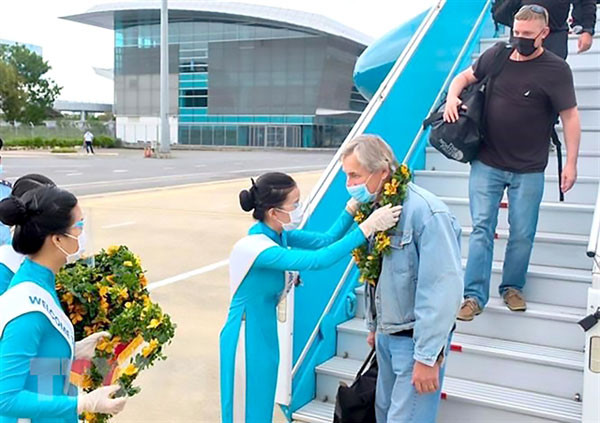
On November 17, 2021, a flight carrying 29 foreign tourists landed at Da Nang Airport.
The flight departed from Seoul and was carrying the first foreign tourists to visit Vietnam, two years on from the country closing the border and cancelling all international flights due to the COVID-19 pandemic.
The flight came shortly after the Government issued Resolution 128 on safe and flexible adaption to and effective control of the COVID-19 pandemic. The Resolution, which agreed with a pilot roadmap to reopen borders to foreign tourists last November, has played a key role in the tourism industry's gradually recovering after the COVID-19 pandemic.
One year after the Resolution was adopted, the industry achieved many positive and impressive results.
Director General of the Ministry of Culture, Sports and Tourism's Vietnam National Administration of Tourism Nguyen Trung Khanh said in 2019, Vietnam was among the ten countries with the fastest tourism growth in the world, with more than 18 million international visitors and 85 million domestic visitors. The country earned roughly VND720 trillion (US$30.05 billion) from the sector.
However, the outbreak of the COVID-19 pandemic has frozen the country's tourism industry for two years. As a result, Vietnam stopped welcoming international arrivals in March 2020 while domestic tourism was delayed and disrupted.
By the end of 2021, Resolution 128 was adopted and piloted in Phu Quoc Island in Kien Giang Province, Hoi An Ancient Town in Quang Nam Province, Nha Trang City in Khanh Hoa Province, Ha Long City in Quang Ninh Province and HCM City.
During two weeks, these provinces welcomed nearly 1,000 international visitors.
The Vietnam National Administration of Tourism guided localities and businesses to implement measures to respond to the pandemic and propose policy packages on finance and social security to support businesses and workers.
It regularly conducted online advertising for both domestic and international visitors. A campaign called "Live fully in Vietnam" was launched to welcome international tourists back to five destinations, including the northern province of Quang Ninh, the three central coastal localities of Quang Nam, Da Nang, and Khanh Hoa; and Phu Quoc Island in the southern province of Kien Giang.
On March 15, Vietnam officially reopened to international tourists, boosting the recovery at a fast pace after the pandemic was under control.
Tourism flourishes
The search volume for Vietnamese tourism has been surging while the number of international arrivals has also been rising.
Domestic travel has continued to play an essential role in Vietnam's tourism. In the first six months of the year, the total number of domestic tourists has reached about 87 million, far exceeding the year plan of 60 million.
International tourists have reached nearly 1.8 million, bringing total revenue of nearly VND400 trillion ($16.69 billion), or about 78 per cent of the earnings in the same period in 2019 before the COVID-19 pandemic.
Hanoi, one of the critical areas of the country's tourism, has welcomed over 13.8 million visitors in the past nine months, an increase of more than four times compared to the same period in 2021. As a result, total revenue is estimated to reach VND39.69 trillion, up 4.7 times over the same period of last year.

Lao Cai, with a series of unique and attractive tourism products such as the Sa Pa love market, Bac Ha White Plateau Festival, rose-wine festival, and snow festival, has attracted about two million visitors.
Kien Giang Province has made remarkable progress with over 6.1 million visitors, exceeding 9.2 per cent of the year plan. Phu Quoc Island has welcomed over four million visitors.
HCM City, the largest metropolis of Vietnam, has received 21.6 million domestic visitors and 2.1 million foreign visitors. At the 29th World Travel Awards Asia & Oceania Gala Ceremony held in HCM City in early September, Vietnam won 48 awards.
Exploiting potential markets
According to the latest UNWTO World Tourism Barometer, Asia-Pacific has the slowest sign of recovery, with arrivals reaching only 14 per cent of pre-pandemic levels in the first nine months of this year.
The reason is that many countries still apply strict COVID-19 prevention and control policies.
In Vietnam alone, the National Administration of Tourism admitted that the number of international arrivals only reached about 30 per cent of the targeted set for this year and 85.4 per cent lower than in the same period in 2019.
The administration said there are still difficulties in attracting international visitors to Vietnam after the pandemic.
About 60-70 per cent of international visitors come from Northeast Asia, which has not yet fully opened to tourism. Therefore, the peak time of international tourists has not started.
A shortage of tourism promotion offices abroad has restricted Vietnam's tourism development compared to Thailand, Singapore, and Indonesia.
The administration said it is necessary to focus on key tourism markets such as Northeast Asia, Southeast Asia, Europe, and North America and promote potential markets such as India and China in the coming time.
Key tourism products include sea and island tourism, resort, cultural tourism, natural tourism, ecotourism and city tourism. It said that new products such as healthcare tourism, sports tourism, and golf tourism should also be promoted.
Source: Vietnam News